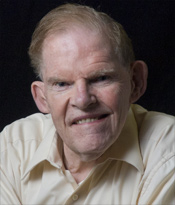
Over the weekend I heard the news that Haddon Robinson–seminary professor, seminary president, and one of the most influential preachers of the last 50 years– had passed away. The 86-year-old author and teacher died on July 22, 2017, leaving behind his wife, Bonnie, of 66 years. Robinson’s conversion story is worth reading, and his lifetime of ministry well worth noting.
Let me add just a few personal remarks.
I didn’t know Haddon Robinson well. I took homiletics from him at Gordon-Conwell in the early 2000s. I never was and never will be a Haddon clone. I didn’t win any preaching awards at seminary. My sermons were just a few more drops in a deep well of bad messages Haddon has to listen to over the years. When I saw Haddon a couple times in the ensuing years, while returning to my alma mater to preach or lecture, I think he sort of remembered me, but not much. There was no reason he needed to.
But here’s what I remember.
The man practiced what he preached. Literally. His sermons in chapel were always stunning examples of construction, concision, and storytelling. I never completely embraced Haddon’s method, but there was no doubt he was a master at his craft. His lectures were as good as his sermons. During my college and seminary days I had some good lecturers and some bad lecturers. But no one lectured like Haddon. It was obvious he had labored (though effortlessly, it seemed) over every illustration, every opening, every transition. I never heard him give a boring talk. He always spoke without notes and always spoke amazingly well. He knew what made two hours feel like twenty minutes.
He was also incredibly disciplined, at least from everything I saw. My friends and I would joke about how often we saw Haddon working out in the gym and how we saw him every morning in the cafeteria reading the paper. He was there to catch up on the news, I suppose, and there to be friendly to students. But mostly I think he was continuing the disciplined practice and finding and filing sermon illustrations. We were required to find 70 sermon illustrations for his class (I think that was the number) and come up with a filing system that worked for us. I hated that requirement so much that I took Preaching II pass/fail so I wouldn’t have to do it. Would my sermons today be better if I had a system for finding and filing sermon illustrations? I don’t know. But his sermons were.
The poor man, by virtue of his profession, had to sit through thousands of awful sermons. I’ll never forget the comment he made after my first mini-sermon in his class. Haddon was refreshingly frank in his evaluations. He wasn’t cruel, but he wasn’t overly sympathetic to our nerves or our fragile egos. I appreciated that about him. Toward the end of his on-the-spot, in-front-of-the-class evaluation, he said, “Kevin, that illustration you gave, well, it was better than nothing.” The class started laughing, but he wasn’t poking fun, just being candid. “No, I mean it,” he continued. “You knew that you needed something there, and what you came up with was better than nothing.” Only slightly so, I imagine.
During my time at Gordon-Conwell, Big Idea preaching was definitely the order of the day. We used Haddon’s textbook and others like it. I was more enamored with the Puritans and Piper and Lloyd-Jones than with every jot and tittle of Haddon’s approach. But looking back, I learned more from him than I realized at the time. I learned the difference between the exegetical main point and the homiletical main point. I learned about explaining, illustrating, applying, and defending the text. I learned—how could I not?—to look for one big idea. Do I preach like a Haddon disciple? I’m sure not. But I still stop to ask myself all the time, Okay, what is the one thing the author here is trying to communicate? I often tell pastoral interns, “Your sermon needs to pass the 2 a.m. test. If Miss Betty calls you in the middle of the night and asks you what the sermon is about, you better be able to tell her in a brief phrase or sentence so you can both go back to sleep.” If the point of the sermon isn’t clear to us, it won’t be clear to anyone else.
So let me add my voice to many others giving thanks for Haddon’s life and ministry. The man who did so much to champion one Big Idea can now focus on one Big Thing and one Big God for the rest of eternity. And that’s something infinitely better than nothing.



